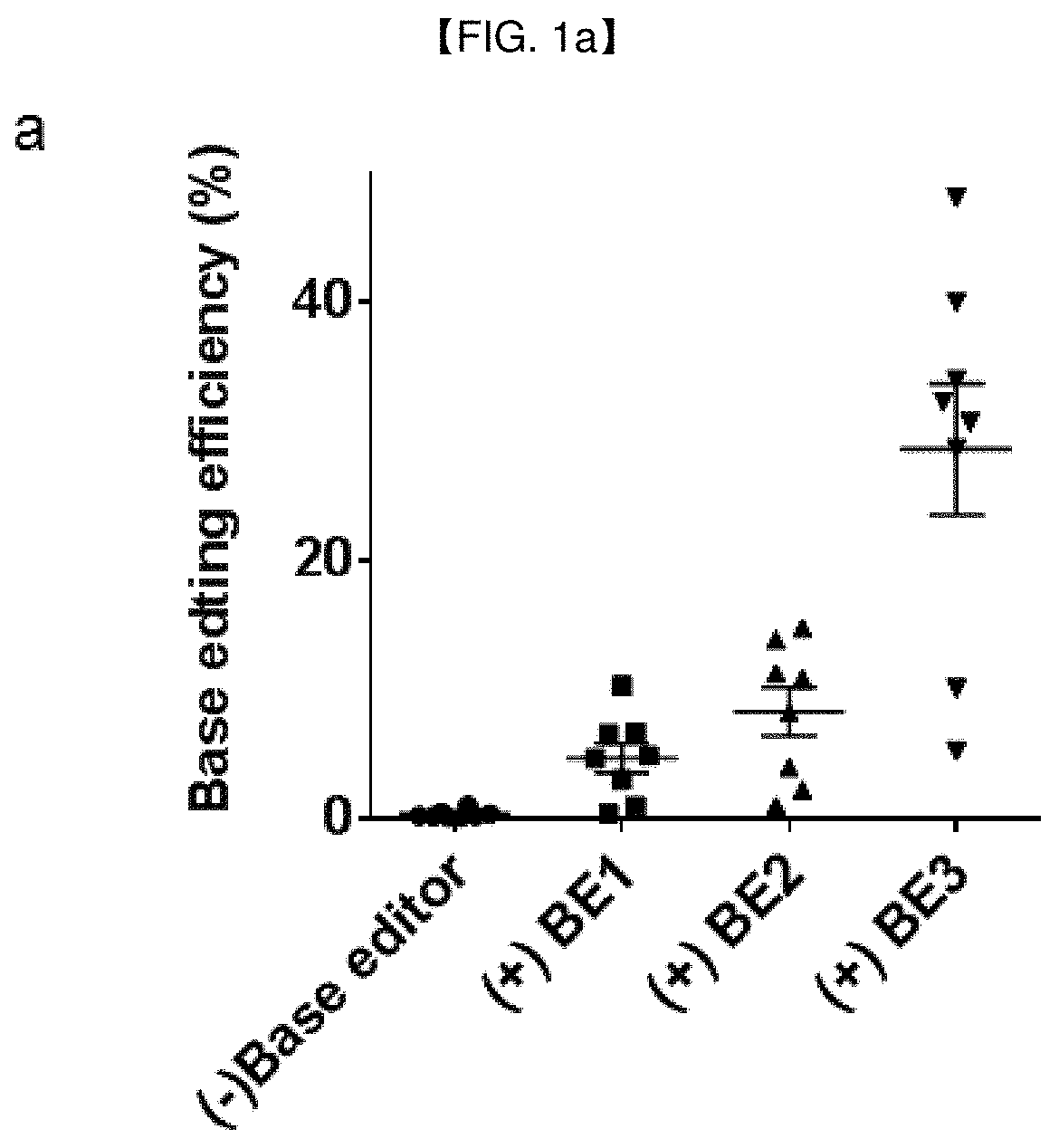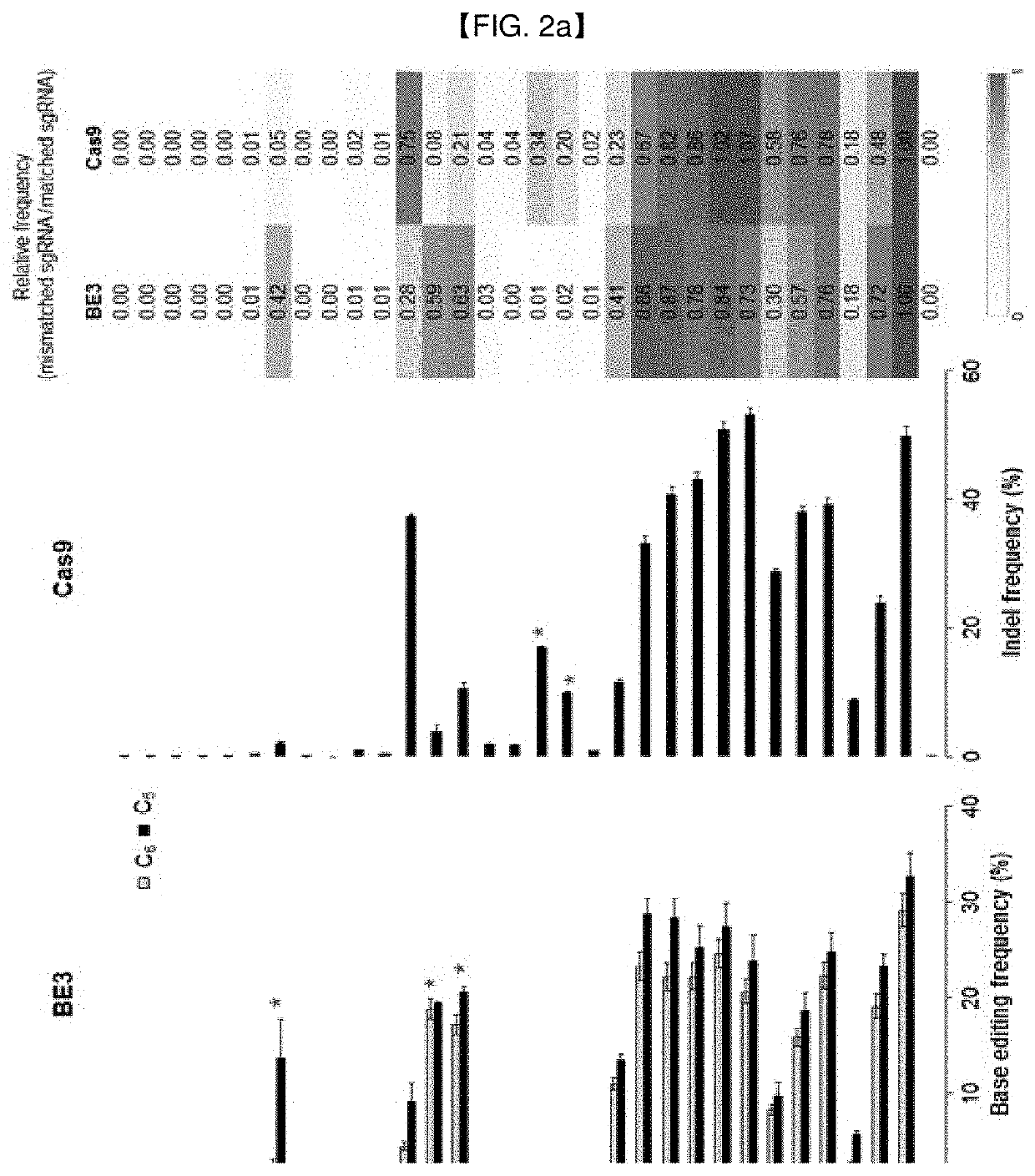Method for identifying DNA base editing by means of cytosine deaminase
a cytosine deaminase and base editing technology, applied in the field of dna double-strand break composition, can solve the problems of genome-wide target-specificity of these rna-programmable deaminases, which have not been developed any means for analyzing target-specificity of programmable deaminases to the whole genome, and achieve accurate and efficient validation of base editing sites
- Summary
- Abstract
- Description
- Claims
- Application Information
AI Technical Summary
Benefits of technology
Problems solved by technology
Method used
Image
Examples
example 1
n of BE3-Associated Base Editing Efficiency and Cas9-Associated Indel Frequency in Human Cells
[0197]Base editing efficiencies, defined by single-nucleotide substitution frequencies, of three different forms of BEs, at seven genomic loci (EMX1, FANCF, HEK2, RNF2, HEK3, HEK4 and HBB) in HEK293T cells were determined, and compared with genome editing efficiencies, defined by indel frequencies at target sites, of Cas9 nucleases (FIG. 1a,b). FIG. 1a shows the base editing efficiencies resulted from BE1 (APOBEC1-dCas9), BE2 (APOBEC-dCas9-UGI) and BE3 (APOBEC-nCas9-UGI) (Reference Example 1) in seven endogenous target sites (EMX1, FANCF, HEK2, RNF2, HEK3, HEK4, HBB) of HEK293T cells. The base editing efficiency was measured by targeted deep sequencing (Reference Example 6). The efficiency of BE3 [APOBEC-nCas9-UGI (uracil DNA glycosylase inhibitor), 29±6%] is superior to that of BE1 (APOBEC1-dCas9, 5±1%) and BE2 (APOBEC-dCas9-UGI, 8±2%). FIG. 1b shows the Cas9 nuclease-induced mutation freq...
example 2
of BE3 and Cas9 to Mismatched sgRNAs
[0198]To assess specificities of BE3 deaminases, it was examined in a cell whether BE3 can tolerate mismatches in small guide RNAs (sgRNAs). To this end, plasmids encoding BE3 or Cas9 (Reference Example 1) and sgRNAs with one to four mismatches were co-transfected into HEK293T cells, to measure mutation frequencies at three endogenous sites (EMX1, HBB, RNF2).
[0199]The used target sites (including the PAM sequence (in bold)) of the sgRNA with 1 to 4 mismatches are summarized in Table 1 below:
TABLE 1SEQEMX1SEQSEQRNF2IDmismatchedIDHBB mismatchedIDmismatchedNO:sgRNAsNO:sgRNAsNO:sgRNAs 1GgactCGAGC32GccatCCCAC63GctgcCTTAGAGAAGAAGAAAGGGCAGTAATCATTACCTG 2GAGTttagGC33GTTGttttAC64GTCActccAGAGAAGAAGAAAGGGCAGTAATCATTACCTG 3GAGTCCGAat34GTTGCCCCgtgaG65GTCATCTTgactAgaAAGAAGAAGCAGTAACGGTTACCTGAGG 4GAGTCCGAGC35GTTGCCCCACAG66GTCATCTTAGTCAGggagAGAAaatgGTAACGGgccgCCTGAGG 5GAGTCCGAGC36GTTGCCCCACAG67GTCATCTTAGTCAGAAGAgaggGGCAacggCGGATTAttcaAGG 6GAactCGAGC37GTcatCCCACAG...
example 3
Seq for Identifying BE3 Off-Target Sites in Human Genome
[0204]Several different cell-based methods, which include GUIDE-seq (Tsai, S. Q. et al. GUIDE-seq enables genome-wide profiling of off-target cleavage by CRISPR-Cas nucleases. Nature biotechnology 33, 187-197 (2015)), HTGTS (Frock, R. L. et al. Genome-wide detection of DNA double-stranded breaks induced by engineered nucleases. Nature biotechnology (2014)), BLESS (Ran, F. A. et al. In vivo genome editing using Staphylococcus aureus Cas9. Nature 520, 186-191 (2015)), and IDLV capture (Wang, X. et al. Unbiased detection of cleavage by CRISPR-Cas9 and TALENs using integrase-defective lentiviral vectors. Nature biotechnology 33, 175-178 (2015)), have been developed for identifying genome-wide off-target sites at which Cas9 nucleases induce DSBs. None of these methods, at least in their present forms, are suitable for assessing the genome-wide specificities of programmable deaminases, simply because deaminases do not yield DSBs. We...
PUM
| Property | Measurement | Unit |
|---|---|---|
| nucleic acid sequence analysis | aaaaa | aaaaa |
| nucleic acid sequence | aaaaa | aaaaa |
Abstract
Description
Claims
Application Information
 Login to View More
Login to View More - R&D
- Intellectual Property
- Life Sciences
- Materials
- Tech Scout
- Unparalleled Data Quality
- Higher Quality Content
- 60% Fewer Hallucinations
Browse by: Latest US Patents, China's latest patents, Technical Efficacy Thesaurus, Application Domain, Technology Topic, Popular Technical Reports.
© 2025 PatSnap. All rights reserved.Legal|Privacy policy|Modern Slavery Act Transparency Statement|Sitemap|About US| Contact US: help@patsnap.com



